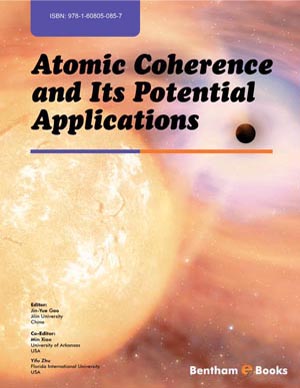Preface
Page: iii-iv (2)
Author: Claire David and Zhaosheng Feng
DOI: 10.2174/978160805140311001010iii
List of contributors
Page: v-v (1)
Author: Claire David and Zhaosheng Feng
DOI: 10.2174/97816080514031100101000v
Abstract
Full Text Available.
Introduction: Classical nonlinear evolution equations and solitary waves
Page: 1-7 (7)
Author: Claire David
DOI: 10.2174/978160805140311001010001
PDF Price: $15
Abstract
Since the first description by John Scott Russel in 1834, the solitary wave phenomenon has raised lots of interests from scientists. This chapter, which plays the part of an introduction to the book, briefly recalls the history of the solitary wave phenomenon study, and presents classical nonlinear evolution equations.
Exact analytic solutions of nonlinear evolution equations
Page: 8-22 (15)
Author: Claire David
DOI: 10.2174/978160805140311001010008
PDF Price: $15
Abstract
This chapter presents the main classical methods used to obtain exact explicit solutions of classical nonlinear evolution equations.
The panel of resolution methods
Page: 23-32 (10)
Author: Claire David
DOI: 10.2174/978160805140311001010023
PDF Price: $15
Abstract
This chapter presents the main classical methods used to obtain solutions of Classical nonlinear evolution equations.
Asymptotic behavior of solitary waves
Page: 33-47 (15)
Author: Claire David and Qingguo Meng
DOI: 10.2174/978160805140311001010033
PDF Price: $15
Abstract
This chapter presents a study of the asymptotic behavior of solitary waves.
Some Aspects concerning the Numerical Computation of Solitons
Page: 48-60 (13)
Author: Laurent Di Menza
DOI: 10.2174/978160805140311001010048
PDF Price: $15
Abstract
The aim of this short review paper is to give a few methods in order to calculate stationary states for nonlinear dispersive equations arising in various physical contexts among which fluid theory. The shooting method and the continuation method will be emphasized.
Attractor and traveling wave solutions for 3D Ginzburg-Landau type equation
Page: 61-122 (62)
Author: Shujuan Lu
DOI: 10.2174/978160805140311001010061
PDF Price: $15
Abstract
In this chapter, we consider the initial value problem of a Ginzburg- Landau equation with spatial periodicity condition in three dimension. Firstly, In Section 2 we prove the existence of local solution (see Theorem 2.1). Furthermore, the existence and uniqueness of global solution are proved by making a prior estimate for solution u(t) (see Theorem 2.2 and 2.3). In Section 3, the existence of global attractor and upper bound estimates for its Hausdorff dimensions and fractal dimensions are obtained (see Theorem 3.2 and 3.3). Then, in Section 4 the existence of finite dimensional exponential attractor is proved (see Theorem 4.2). In Section 5, we construct a fully discrete Fourier spectral approximation scheme for problem (1.4)-(1.6) and then prove the existence and convergence of approximate attractors (see Theorem 5.2.1 and 5.3.2) are presented. Moreover, the long-time
The Dynamics of Two Classes of Singular Nonlinear Traveling Wave Equations and Loop Solutions
Page: 123-201 (79)
Author: Jibin Li
DOI: 10.2174/978160805140311001010123
PDF Price: $15
Abstract
In this chapter, applying the qualitative theory of planar dynamical systems, we study the traveling solitary wave solutions and loop solutions of several nonlinear evolution equations. Dynamical behaviors and phase portraits are illustrated by numerical simulations in differential parametric regions. Three typical traveling wave equations are carefully investigated. All phase portraits of their corresponding traveling waves with different profiles are given. Analysis from a theoretical viewpoint of dynamical systems shows that the so-called loop- and inverted-loop-soliton solutions, as well as loop-periodic solutions reportedly existing in the above three equations, are merely visual illusion of numerical artifacts. To reveal the mystery, all the exact parametric representations of traveling wave solutions of the above three equations are derived in precise analytical forms.
The interrelationship of integrable equations, differential geometry and the geometry of their associated surfaces
Page: 202-252 (51)
Author: Paul Bracken
DOI: 10.2174/978160805140311001010202
PDF Price: $15
Abstract
A survey of some recent and important results which have to do with integrable equations and their relationship with the theory of surfaces is given. Some new results are also presented. The concept of the moving frame is examined, and it is used in several subjects which are discussed. Structure equations are introduced in terms of differential forms. Forms are shown to be very useful in relating geometry, equations and surfaces, which appear in many sections. The topics of the chapters are different and separate, but joined together by common themes and ideas. Several subjects which are not easy to access are reviewed and elaborated upon. These topics include Maurer-Cartan cocycles and recent results with regard to generalizations of the Weierstrass-Enneper system forgenerating constant mean curvature surfaces in three and higher dimensional Euclidean spaces.
Index
Page: 253-255 (3)
Author: Claire David and Zhaosheng Feng
DOI: 10.2174/978160805140311001010253
Abstract
Full Text Available.
Introduction
Since the first description by John Scott Russel in 1834, the solitary wave phenomenon has attracted considerable interests from scientists. The most interesting discovery since then has been the ability to integrate most of the nonlinear wave equations which govern solitary waves, from the Korteweg-de Vries equation to the nonlinear Schrödinger equation, in the 1960's. From that moment, a huge amount of theoretical works can be found on solitary waves. Due to the fact that many physical phenomena can be described by a soliton model, applications have followed each other, in telecommunications first, where the propagation of solitons in fiber optics helps in increasing transmission capacity, thanks to their inherent stability, which make long-distance transmission possible without the use of repeaters. The aim of this book is to present a state of the art theoretical study of solitary waves. Prominent actual works on solitary waves are described.








.jpg)




